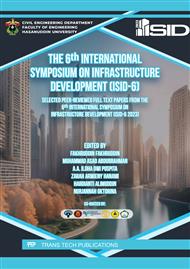[1]
F. Amann et al., "Analysis of acoustic emissions recorded during a mine-by experiment in an underground research laboratory in clay shales," Int. J. Rock Mech. Min. Sci., vol. 106, no. February, p.51–59, (2018).
DOI: 10.1016/j.ijrmms.2018.04.021
Google Scholar
[2]
I. Zarkasi, H. Irpanni, and H. Arifien, "Penanganan Jembatan Cisomang ruas tol Cikampek-Padalarang: pembelajaran penanganan jembatan akibat pergerakan tanah clay shale," J. HPJI (Himpunan …, vol. 4, no. 1, p.25–36, (2018).
Google Scholar
[3]
E. Hartono, S. P. R. Wardani, and A. S. Muntohar, "The behavior of the clay shale stabilized by dry and wet cement mixing method," J. Geoengin., vol. 16, no. 3, p.81–90, (2021).
Google Scholar
[4]
D. P. Kusumastuti and I. Sepriyanna, "Soft soil stabilization with rice husk ash and glass powder based on physical characteristics," IOP Conf. Ser. Mater. Sci. Eng., vol. 650, no. 1, p.1–6, (2019).
DOI: 10.1088/1757-899x/650/1/012025
Google Scholar
[5]
H. Adisurya and C. A. Makarim, "Perilaku kegagalan konstruksi jalan raya yang bertumpu pada fondasi tiang di tanah clay shale," JMTS J. Mitra Tek. Sipil, vol. 5, no. 1, p.55–70, (2022).
DOI: 10.24912/jmts.v5i1.16516
Google Scholar
[6]
M. Gutierrez, R. Nygård, K. Høeg, and T. Berre, "Normalized undrained shear strength of clay shales," Eng. Geol., vol. 99, no. 1–2, p.31–39, (2008).
DOI: 10.1016/j.enggeo.2008.02.002
Google Scholar
[7]
A. M. A. Putera, S. Pramusandi, and B. Damianto, "Identification and classification of clayshale characteristic and some considerations for slope stability," African J. Environ. Sci. Technol., vol. 11, no. 4, p.163–197, (2017).
DOI: 10.5897/ajest2014.1792
Google Scholar
[8]
I. M. Alatas and P. T. Simatupang, "Pengaruh proses pelapukan clay shale terhadap perubahan parameter rasio disintegritas (DR)," J. Tek. Sipil ITB, vol. 24, no. 1, p.77–82, (2017).
Google Scholar
[9]
A. Yusuf, I. Dio, and kresno wikan S, "Perilaku clay shale terhadap kuat geser residual," J. Karya Tek. Sipil, Vol. 6, No. 3, (2017), p.81–92.
Google Scholar
[10]
M. Irsyam, A. Sahadewa, A. Boesono, and Soebagyo, "Pengaruh strength reduction tanah cay-shale akibat pelaksanaan pemboran terhadap nilai daya dukung pondasi tiang di Jembatan Suramadu berdasarkan analisis hasil tes OC," J. Tek. Sipil ITB, Vol. 14, No. 2, (2007),p.1–11.
DOI: 10.5614/jts.2007.14.2.1
Google Scholar
[11]
F. Z. Waskito, G. Pamungkas, S. Hardiyati, and K. W. Sadono, "Analisa stabilitas lereng clayshale pada pekerjaan pembangunan jalan tol Bawen-Salatiga paket 3 . 1," J. Karya Tek. Sipil, Vol. 5, No. 2, (2016), p.211–219.
Google Scholar
[12]
S. Widyastuti, Abdurrokhim, and Y. A. Sendjaja, "Asal sedimen batupasir Formasi Jatiluhur dan Formasi Cantayan Daerah Tanjungsari dan sekitarnya, Kecamatan Cariu, Kabupaten Bogor, Provinsi Jawa Barat," Bull. Sci. Contrib., Vol. 14, No. 1, (2016), p.25–32.
DOI: 10.31315/jigp.v9i2.9504
Google Scholar
[13]
L. Jurnaliah, "Paleoekologi satuan batulempung formasi Jatiluhur daerah Cileungsi , kecamatan Cileungsi, kabupaten Bogor, Jawa Barat," Bull. Sci. Contrib., Vol. 4, No. 1, (2006), p.78–87.
DOI: 10.14203/risetgeotam2018.v28.660
Google Scholar
[14]
R. Oktaviani, P. P Raharjo, and I. A Sadisun, "Kajian ketahanan batuan clay shale formasi Jatiluhur di Sentul City Jawa Barat," Promine, Vol. 6, No. 1, (2018), p.26–32.
DOI: 10.33019/promine.v6i1.715
Google Scholar
[15]
A. Idrus M, S. Pintor T, K. Wawan, and Panji, "Re-weathering of stabilized clay shale with portland cement behavior," in MATEC Web of Conferences, Vol. 276, (2019), p.1–9.
DOI: 10.1051/matecconf/201927605009
Google Scholar
[16]
W. Diana, E. Hartono, and A. S. Muntohar, "The permeability of portland cement-stabilized clay shale," in IOP Conference Series: Materials Science and Engineering, Vol. 650, No. 1, (2019), p.1–8.
DOI: 10.1088/1757-899x/650/1/012027
Google Scholar
[17]
BSN, "SNI 3420:2016 Metode uji kuat geser langsung tanah tidak terkonsolidasi dan tidak terdrainase," (2016).
Google Scholar
[18]
SNI 3638, "SNI 3638:2012 Standar Nasional Indonesia Metode uji kuat tekan-bebas tanah kohesif Badan Standardisasi Nasional " Copy SNI ini dibuat oleh BSN untuk," (2012).
DOI: 10.31000/mbjtm.v2i2.1883
Google Scholar
[19]
D. P. Kusumastuti, I. Sepriyanna, and A. S. Nur Chairat, "Pengaruh penambahan serbuk arang cangkang sawit terhadap kuat geser langsung pada tanah lempung," Konstruksia, Vol. 14, No. 1, (2022), p.33–39.
DOI: 10.24853/jk.14.1.33-39
Google Scholar
[20]
M. A. Dafalla, "Effects of clay and moisture content on direct shear tests for clay-sand mixtures," Adv. Mater. Sci. Eng., Vol. 2013, (2013).
DOI: 10.1155/2013/562726
Google Scholar
[21]
I. Abdullahi, U. U. Umoh, and A. C. Aapta, "Effect of varying moisture content on shear strength properties of soil," Saudi J. Civ. Eng., Vol. 6, No. 11, (2022), p.256–263.
DOI: 10.36348/sjce.2022.v06i11.001
Google Scholar
[22]
D. Adrian, I. B. Mochtar, and N. E. Mochtar, "Analisa sudut-geser-dalam tanah berbutir halus (cohesive soil) berdasarkan pendekatan cracked soil," J. Tek. ITS, Vol. 8, No. 2, (2019), p.74–78.
DOI: 10.12962/j23373539.v8i2.45898
Google Scholar
[23]
M. Muntaha, L. Caraka, and A. A. I. Saputra, "Karakteristik fisik dan mekanik tanah residual Balikpapan Utara akibat pengaruh variasi kadar air," in The 2nd Conference on Innovation and Industrial Applications, Vol. 2, No. 1, (2016), p.101–108.
DOI: 10.12962/j23546026.y2018i1.3353
Google Scholar
[24]
S. Saptono, R. Hariyanto, H. T. S., and M. D. Wahyudi, "Penentuan pengaruh air terhadap kohesi dan sudut gesek dalam pada batugamping," Progr. Stud. Tek. Pertamb. UPN Veteran Yogyakarta, Vol. 1, No. 1, (2014), p.1–9.
Google Scholar
[25]
R. Fithria and D. P. Kusumastuti, "The effect of wood charcoal powder and pumice powder on the parameters of shear strength of clay soil," Indones. Geotech. J., Vol. 1, No. 2, (2022), p.50–58.
DOI: 10.56144/igj.v1i2.14
Google Scholar
[26]
T. Al-Bazali, "The impact of water content and ionic diffusion on the uniaxial compressive strength of shale," Egypt. J. Pet., Vol. 22, No. 2, (2013), p.249–260.
DOI: 10.1016/j.ejpe.2013.06.004
Google Scholar


